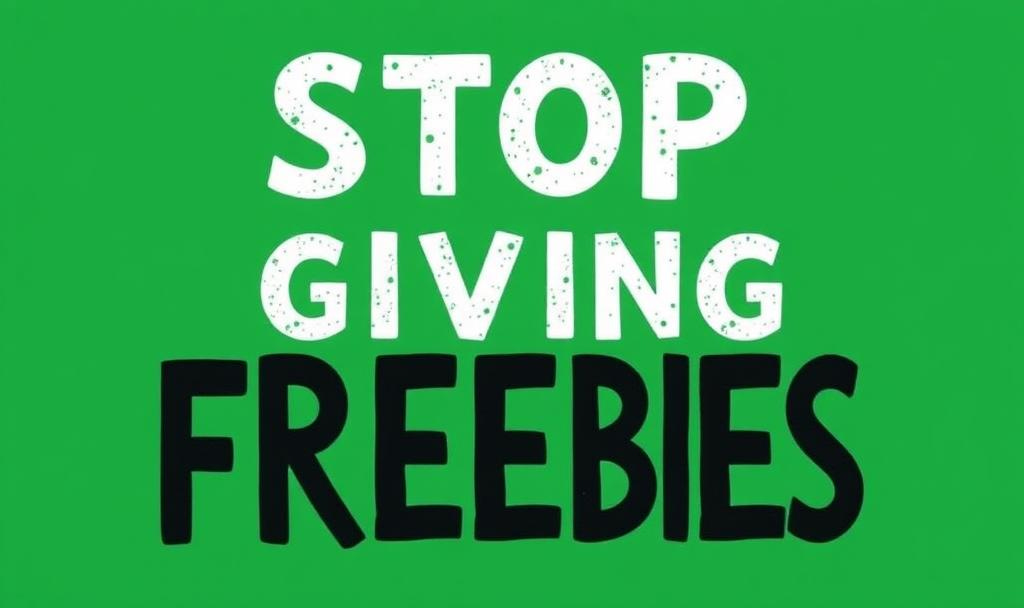Why 'free' often backfires
When someone's paid for your stuff, suddenly they have skin in the game.
Gary Bloomer | SHAKING THE TREE # 208
“If it’s free, it’s for me!”
I used to think free was a great way to attract attention.
Man alive, was I wrong on that front!
Back in 2012, Phil Grisolia, an school marketer and former leading contributor on the Know-How Exchange of MarketingProfs.com was kind enough to share the following story with me about the woes of offering things for free:
Got a friend who’s an Internist (MD) who years ago gave a number of people free shots to help them quite smoking.
They didn’t quit.
But the people he charged for those same shots had a 93% quit rate.
Same thing with his weight control program.
Gave folks free meds and most didn’t lose a pound.
The people he charged for the same meds had a 62% success rate achieving their stated goals.
Proving once again …
… that too many people seem to think that anything you get for nothing is worth only what you paid for it.
Here’s the big problem with all of this: freebies are a crutch for lazy marketers.
You’ve seen it everywhere—“Download our free guide!”, “Get a free consultation!”, “Join our free webinar!”.
Shit! I’ve done it myself!
And sure, while these tactics can work—for a while, and only if your goal is to attract tire-kickers who’ll never buy from you—they won’t make your rich.
So, if you’re serious about building a serious brand that commands respect (and that generates revenue), it’s time to rethink the “free” trap.
The biggest problem with ‘free’ is …
… that is attracts the wrong sort of people.
Free seekers are often time-wasters, tyre kickers, and bargain hunters: they want something for nothing, they're seldom action takers, and they are unlikely to ever become serious buyers.
They’ll hoard your PDFs, they’ll soak up your time, they’ll want to pick your brains, and they’ll ghost your webinars, and vanish when it’s time to pay up.
Meanwhile, your real customers—the ones who value your skills, expertise, and the value you bring—they’re often left wondering why you’re giving away what they paid for.
The other big problem with ‘free’ is …
… it trains people to expect everything for nothing.
When you give everything away, you teach your audience that your knowledge has no value and no price tag.
Why should they pay for your premium service when you’ve already handed them the “secrets” for free?
Another issue with ‘free’ is …
… that it cuts into your profit margins.
Free consultations, free audits, free samples—they all cost you time and money and that will kill your profit margins. And for what? A 1% conversion rate? That’s not marketing; that’s charity.
So, how do you fix all this?
You replace ‘free’ with ‘invite-only’ offers
Scarcity breeds demand. Because webinars are so 2007, consider hosting a live stream for a dedicated group of respondents.
Example: “Apply for our limited-seat strategy session—reserved for executives ready to scale.”
Charge a nominal fee (that you then refund)
A small fee—even $1—filters out freeloaders while maintaining perceived value. Bonus: Refund it after they attend or purchase, and you’ve just built trust and qualified leads.
Example: “Pay $5 to reserve your spot—fully refunded when you show up.”
Give ‘fragmented’ value
Don’t give away the whole cow—offer a taste. Tease high-value insights with the first section of a course or program, then gate off the full solution behind a paid wall that requires leads to take an additional action.
Make them invest time (not just money)
Require effort—a quiz, a survey, a pre-qualification form—to access your offer. This weeds out the lazy and engages the serious.
Example: “Complete this 2-minute audit to unlock your custom report.”
Flip the script: ‘free for a fee’
Bundle the freebie with a paid offer so it enhances value instead of replacing it.
Example: “Buy our course today, and get the $99 toolkit free.”
Free isn’t a strategy—it’s a shortcut.
If you want a brand that’s known for value, not vanity metrics, start treating your expertise like the asset it is.
Give generously, but give strategically.
Because the moment you stop giving away the farm is the moment your audience starts taking you seriously.
All of which is by way of saying that within the next few months, I’ll be putting all my new stuff behind a pay wall. Existing subscribers are locked in. But new people? Not so much.
Now, go charge what you’re worth.
Gary
As always, thanks for reading.
—Gary
Feel free to follow me on Twitter and LinkedIn
If you’ve like what you’ve seen here, why not share this post with a friend?
P.S. Next time on Shaking the Tree … The power of taking action.
ABOUT THE AUTHOR: Originally from the U.K., Gary Bloomer is a writer, branding advocate, marketing specialist, and an award-winning graphic designer.
His design work has been included in Creative Review (one of the UK’s largest design magazines). Since 2009, he has answered over 5,000 marketing and business questions in the Know-How Exchange of MarketingProfs.com, placing him among the top 3% of contributors. He lives in Wilmington, Delaware, USA.

